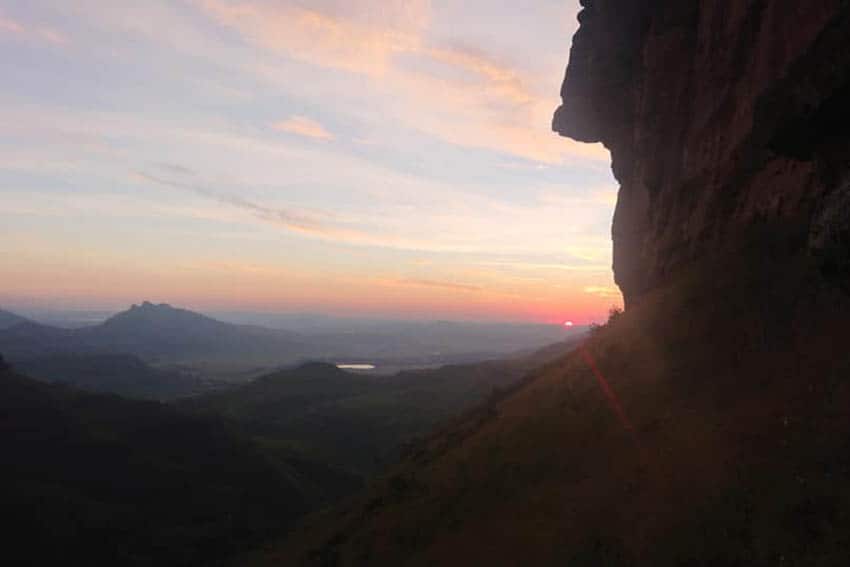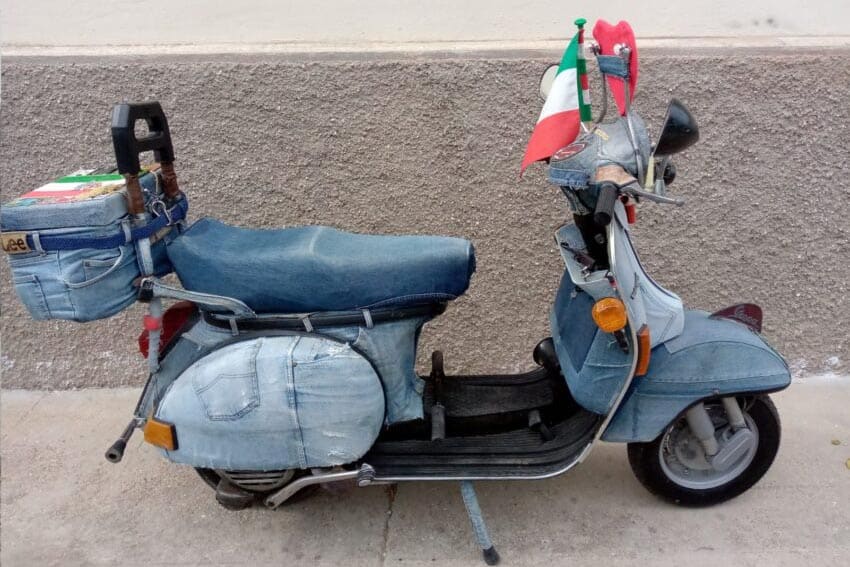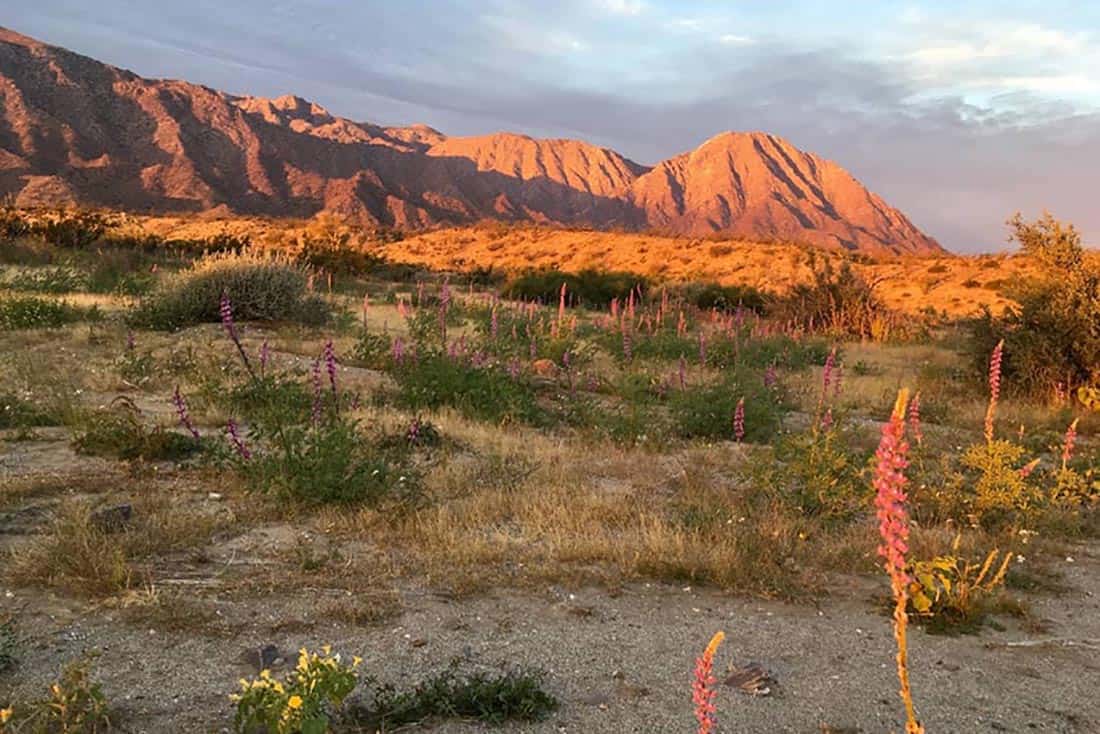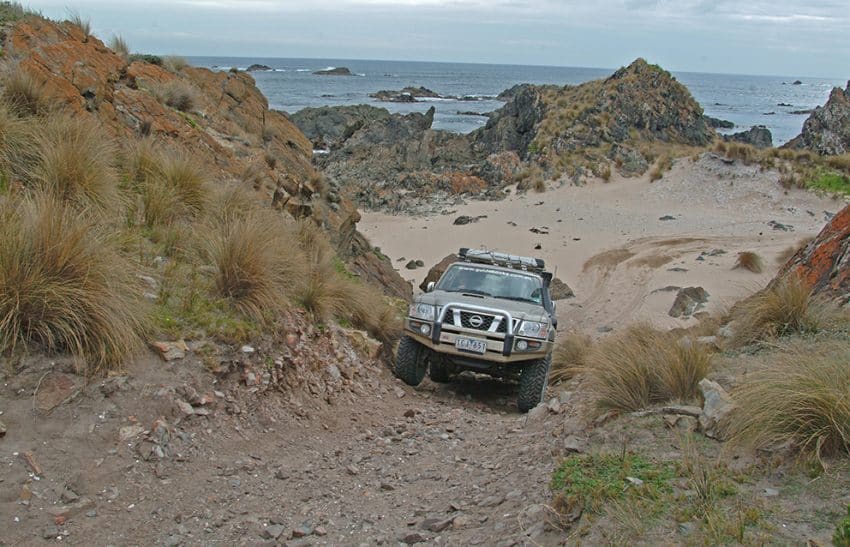
Terrific Tasmania by Four-Wheel-Drive
By Ron and Viv Moon
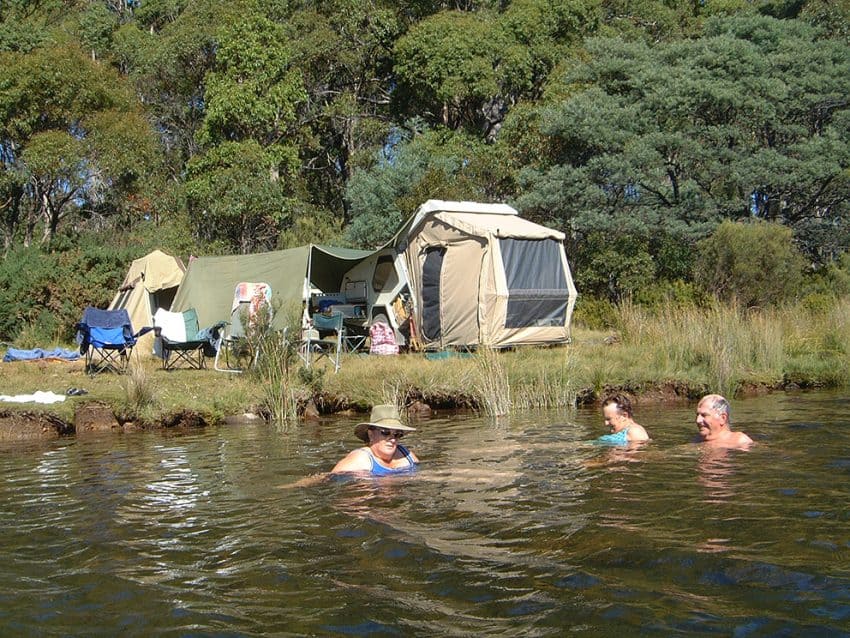
You don’t need a 4WD or an SUV to explore Tasmania but with one you can get off the beaten track, away from the crowds, and have a wide-open book to enjoy.
I spun the wheel hard, the Nissan turning and tracking along the edge of the sandy creek as I looked for a safe and easy way to cross the stream.
Not that it was wide … or deep, but the sand bordering the rivulet was suddenly squelchy soft and the shortest line had begun to look like the worse route to take to cross the water.
We had just got onto the beach at Cloudy Bay and getting stuck within sight of the access ramp would not have looked good!
Bruny Island
After crossing this particular splash of water, we cruised effortlessly along the great arc of sand that separates Whalebone Point from East Cloudy Head.

We were on South Bruny Island along its southern coast, which is a little more exposed than much of the adjoining shore. At the end of the beach at Cloudy Bay, the track climbs off the sand and passes through some low dense scrub to a well-protected and pleasant camping spot just up from the beach.
Those with a small boat or kayak can trailer them along the beach if they choose the tide correctly and launch it off the beach just below the camp.
The area offers good fishing, diving and surfing, while a walking trail leads to East Cloudy Head.
Just west of here the 93-meter (305 feet) Cape Bruny Lighthouse stands tall and proud and was the second oldest manned lighthouse in Australia.
Built in 1836 by convict labor it was decommissioned in 1996 and now tours of the historic light are available (www.capebrunylighthouse.com/).
Thin Sandy Isthmus
The two islands of South and North Bruny are, in fact, joined by a thin sandy isthmus of land where the most popular camp on the islands is located at, what they call, The Neck.
Central to both islands as well as being the closest to the ferry point from the mainland of Tassie, it is the most popular camp spot in the whole area and there is no doubt that it would often be full.
Just over the bordering dune, the long arc of beach that helps form Adventure Bay can be enjoyed.
Historic & Picturesque Adventure Bay

Adventure Bay is one of the most historic sites in Australia with early navigators visiting and replenishing their water and stores here. These included Abel Tasman (1642), Furneaux (1773), James Cook and William Bligh (1777), Bligh again in 1788, followed by Bligh and Matthew Flinders in 1792.
During this voyage, Bligh planted the first apple trees here. In 1792-93, Bruny d’Entrecasteaux (who the island is named after) arrived while Nicolas Baudin ‘s expedition visited in 1802. Bligh arrived for the fourth time in 1808 aboard the ‘Porpoise’, as the deposed governor of the NSW colony.
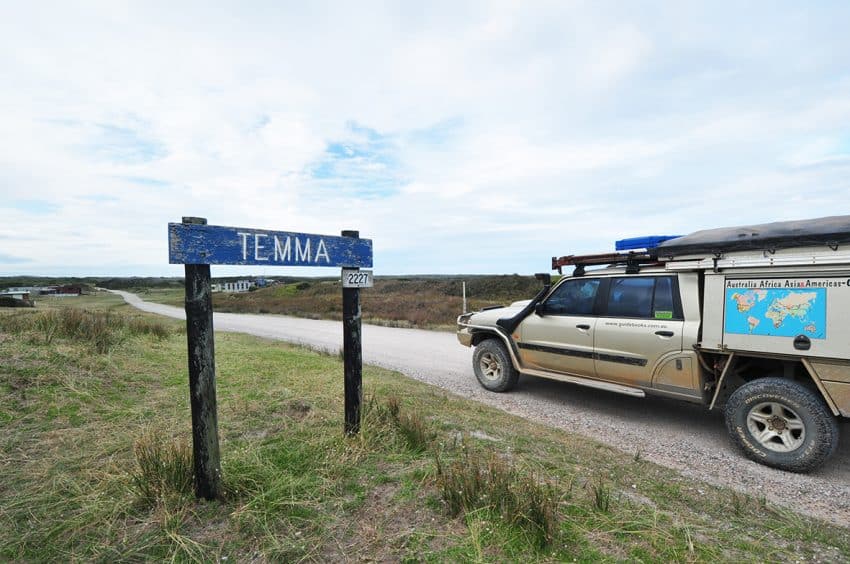
And it is no wonder so many visited … it is a delightful and well-sheltered place. The community tucked into the southeast corner of the bay is the ‘tourist hub’ of the island, and along the coast road, as you enter the town, is the Bligh Museum, which is a little beauty and well worth a look.
In all, we spent five days on these two islands and easily filled that time with exploring the length and breadth of the islands and enjoying a few of the shorter walks. Most of the roads on the place are tarmac or reasonable dirt and of an easy 4WD standard.
Behind Hobart – Mt Wellington
Back on the mainland, there’s plenty of places to see and enjoy around the south-east. Behind Hobart, the rough rocky trails of Mt Wellington can easily fill in a day as well as providing a challenge. The mountain crest (reachable by a normal vehicle) also gives delightful views of the surrounding rugged range country and north across the Derwent Valley.
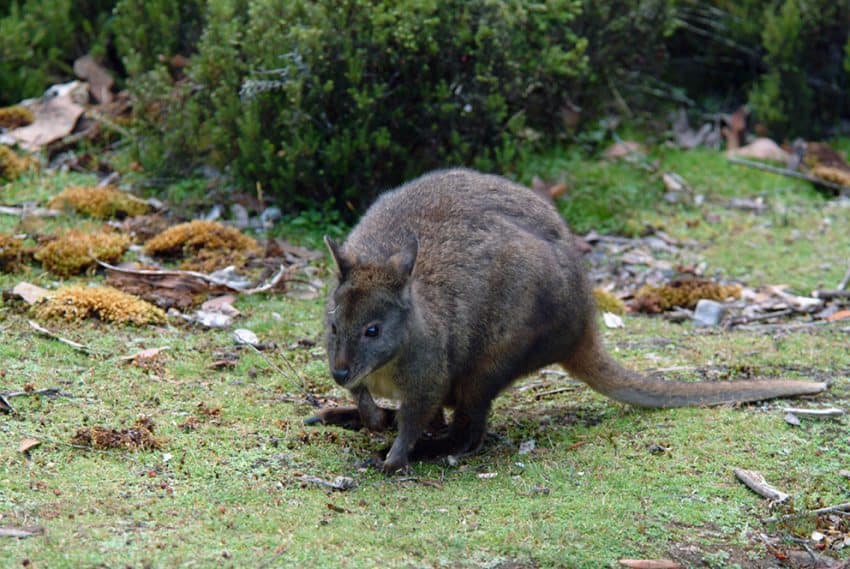
The trails here vary in length and include the East-West Trail, Collins Cap Trail, and the Montrose Trail, all of which you need a permit for as well as an access key.
To the Tahune Forest Air Walk
Using the tracks around Mt Wellington to head from Hobart to Judbury is a great way to take a trip to the Tahune Forest and its spectacular ‘Air Walk’.
Severely impacted by bushfires that raged in this area in early 2019 the Air Walk – one of the biggest tourist attractions in Tasmania – had been closed for some time but has recently re-opened. The surrounding forest is healing and the views are still stunning.
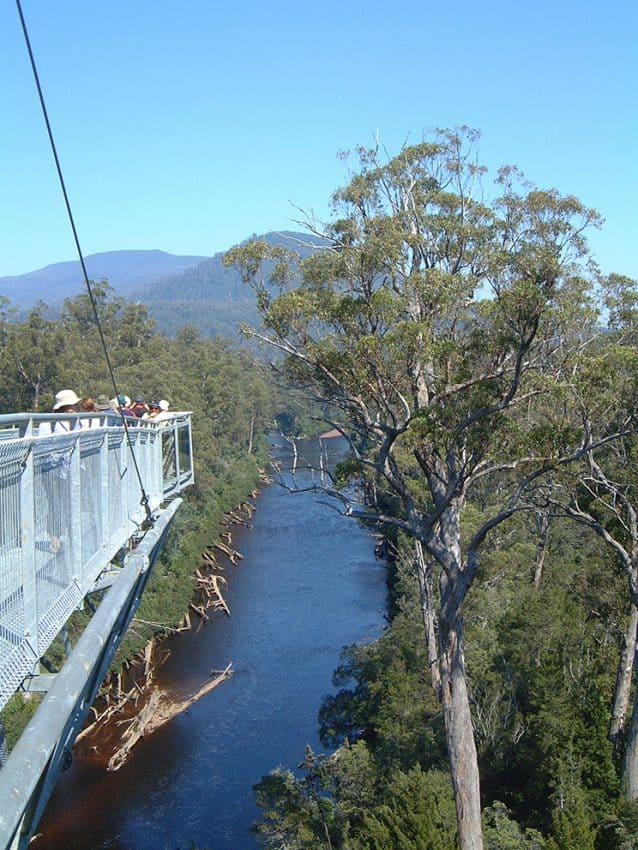
Along the way to the Tahune Forest, the route takes you through the rich Huon River valley and the delightful camping site at Rivers Edge Camping (website).
Potoroos (a small wallaby & a member of the kangaroo family) grazed peacefully on the short clipped grass, platypus could be seen in the nearby stream by those willing to be quiet and patience, while in the evening, beautiful and extremely uncommon native quolls came wandering through looking for a feed of insects, kinks, and smaller mammals.
Tasmania’s Animals
Sometimes you may even spy a muscular, tough Tasmanian devil wandering through the camp.
The Southern-most Road in Australia
From the Tahune Forest, you can head back to the coast at Geeveston and then head along the blacktop to Southport. The nearby Southport Lagoon and its coastal beaches are a favored destination for four-wheelers who love to canoe or kayak in the protected waters of the lagoon.
From Southport, the road turns to maintained dirt and then passes through the tall forest as the route skirts the beautiful and well-protected Recherche Bay.
The north-east peninsula of this picturesque inlet has been protected and listed on the National Estate as it is the area where the 1792 Bruni d’Entrecasteaux expedition set up a scientific base – the first in Australia – as well as planting a ‘French Garden’ there.
There are a few camping spots scattered along the coast; one of the better ones being close to Catamaran.
A few kilometers further on, just before crossing the bridge at Cockle Creek there’s a number of cleared areas close to the road which are popular camping spots and you can understand why. These are in the Recherche Nature Recreation Area while once you cross the bridge you are in the Southwest National Park.
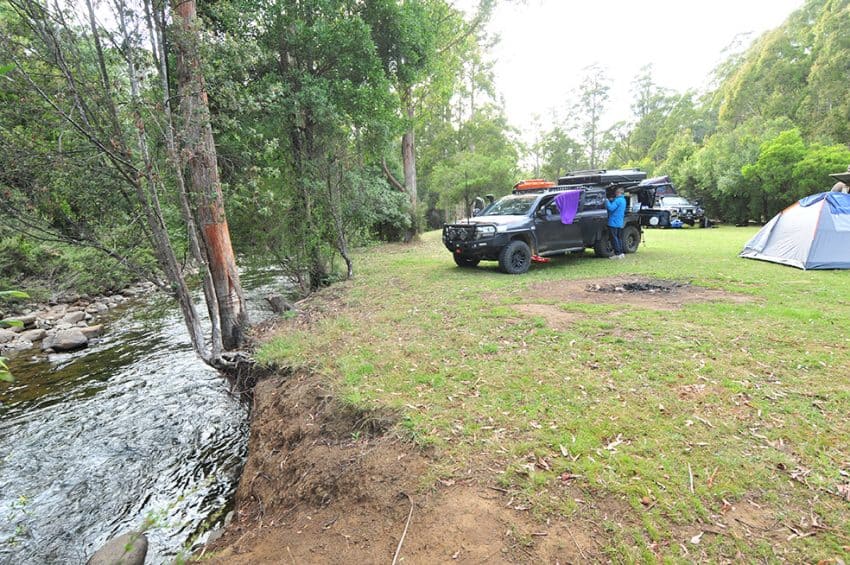
Cockle Creek
Cockle Creek is as far south as you can go in Australia by vehicle, a sign proclaiming that fact as you cross the bridge. At road’s end, a short distance further on a walking track leads 50 meters to a whale sculpture that is testimony to the early whalers who hunted these creatures and the fact that the whales, with protection, have come back and can now be seen along the nearby coast.
Across the Central Plateau
This latest trip to Tassie we left Hobart and wandered through the Central Plateau of the ‘Island State’, as Tasmania is affectionately known by many, camping on one of the multitudes of lagoons that dot the high interior of Tasmania.
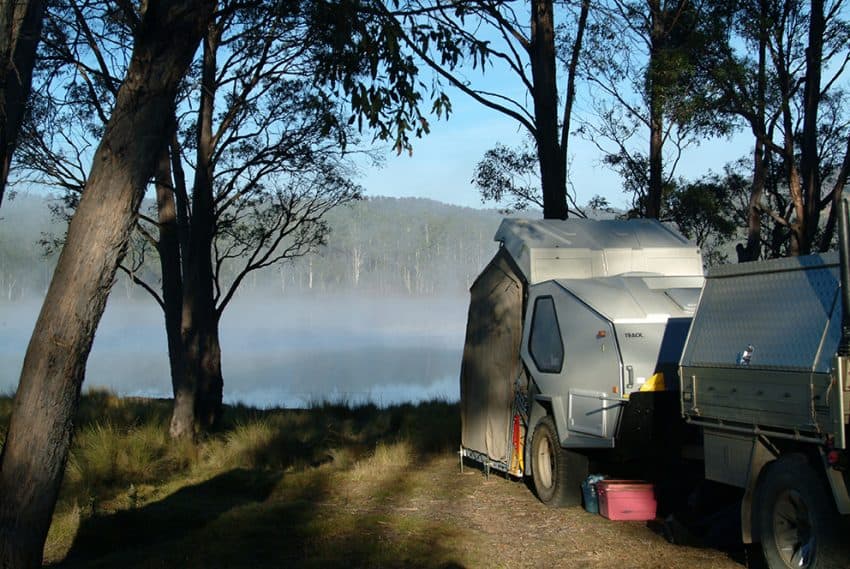
Most of these lagoons were dammed and thereby deepened and enlarged back in the first half of the 20th Century by the state’s Hydro Commission and today they offer tranquil camping spots, world-class trout fishing and pleasure boating and canoeing.
Historic Queenstown
From there we wandered along the blacktop through Derwent Bridge to the historic mining enclave of Queenstown.
Since the smelter closed and stopped belching poisonous fumes and denuding all the hill for miles around, nature has now reclaimed much of the man-made devastation and the scenery is all the better for it.
When you are there, take the time to enjoy the West Coast Wilderness Railway which runs between Queenstown and Strahan. The famous and unique steam-powered rack-and-pinion Abt train chugs through the delightful rainforest and across numerous streams. Kids, steam buffs … everyone … will love the experience!
Strahan and Macquarie Harbour
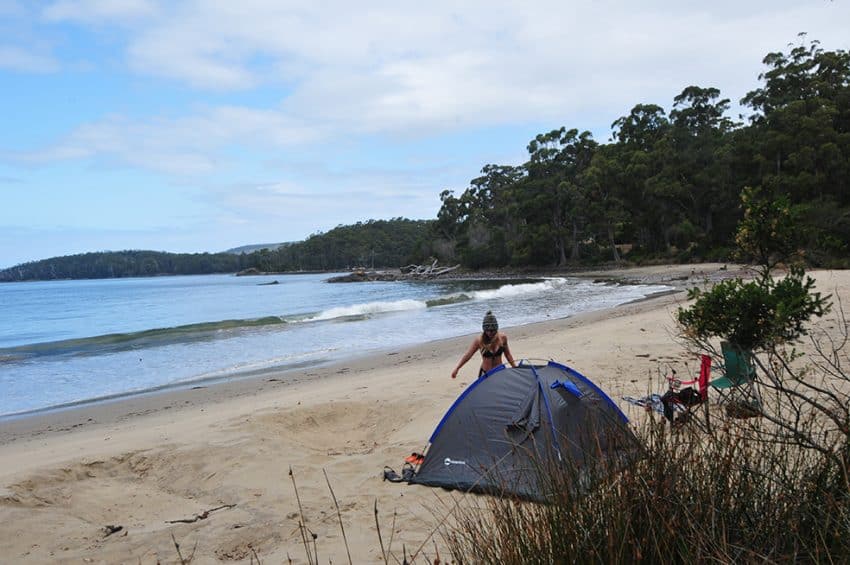
Down the hill and perched on the edge of Macquarie Harbour, one of the largest natural harbors in Australia, is the small but important village of Strahan.
Originally established in the 1870s as an access point for the nascent mining industry it soon became an outlet for the regions Huon pine and fishing enterprises.
Today it thrives on tourism and is well worth a stop of a few days or more.
The harbor’s shallow expanse is fed by a number of not-so-insignificant mountain-fed streams including the Gordon, King, Queen and Bird rivers to name a few.
The narrow outlet at Macquarie Heads gives the raging, rock-strewn opening the name of ‘Hell’s Gate’ and the harbor’s sinister reputation was added to when the area’s first settlement was a convict prison on Sarah Island, established in 1822.
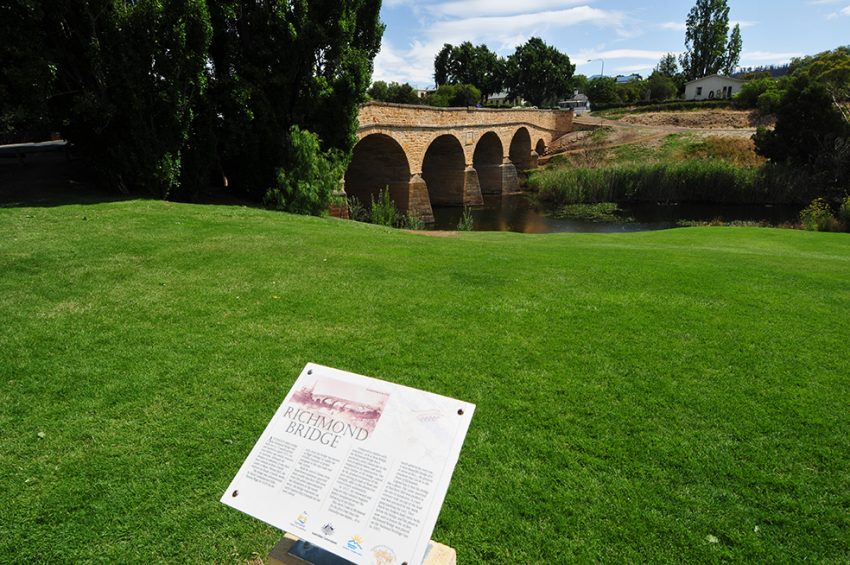
During its 11 years of existence, the prison gained fame as one of the harshest in the country where the use of the cat-of-nine-tails, leg irons, and a flooding small sea cave used for solitary confinement, were common!
Today the ruins can be visited on a cruise of the harbor (and the Heads) and it’s an informative, enjoyable way to spend a day.
Macquarie Heads
That evening we camped out at Macquarie Heads, just a stone’s throw from the water’s edge. Next day we drove onto the beach at the Heads and cruised the Ocean Beach 10km north and took the exit which led back into Strahan.
We had an uncomplicated drive on this last trip, the sand is firm and easy to drive on, but it’s not always so, with winter storms stripping the beach of sand and leaving very little, if any, to drive on.
To Zeehan and along the Western Explorer Highway

We headed off to Zeehan, once the center of the mining industry in this wild rugged region of Tassie, and checked out its great little museum before taking the drive north to Corinna and the ferry across the mighty Pieman River.
Established in 1881 when gold was discovered in the tributaries of the Pieman, Corinna once had a population of around 2500 people; today it has just a half dozen or so, barring visitors.
The town, sits on the edge of the river and the Tarkine Wilderness, the largest temperate rainforest in Australia, while the Tarkine Hotel caters for the passing throng and those wanting to stay awhile.
This last trip we didn’t stay all that long, just long enough to have a beer and a meal before heading north on
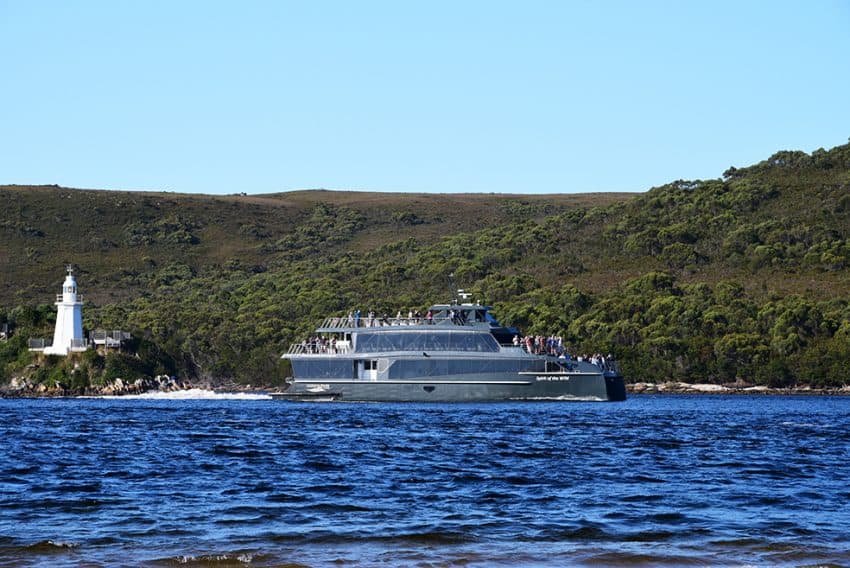
what is officially known as the Western Explorer Highway.
It’s a pretty good gravel road for most of the way, crossing the major streams of the Savage, Donaldson and the Lindsay rivers on bridges and passing through some magical rainforest before climbing onto high button-grass plains. Reaching the tarmac, we turned west to the often raging west coast.
Temma to Sandy Cape
The next day we drove south to Temma, lowered our tire pressures and took to the beaches and headlands for the 40km 4WD trek south to Sandy Cape. It’s not always an easy drive and this trip one of our party got bogged as they crossed a small creek, but our group of experienced beach drivers soon had him unstuck and rolling south again.
Once you get to this wild and wonderful place you’ll find protected camping tucked up in amongst the tea-tree. Meanwhile, the coast, if it’s not too wild, offers snorkeling, fishing, and surfing, while the inside beach at the Cape is often calm and inviting.
It was a fitting place to end our travels around Tasmania and while we had to catch the ferry back to the ‘Big Island’ of Australia, we knew we’d be coming back to our verdant ‘Island State’ once more.
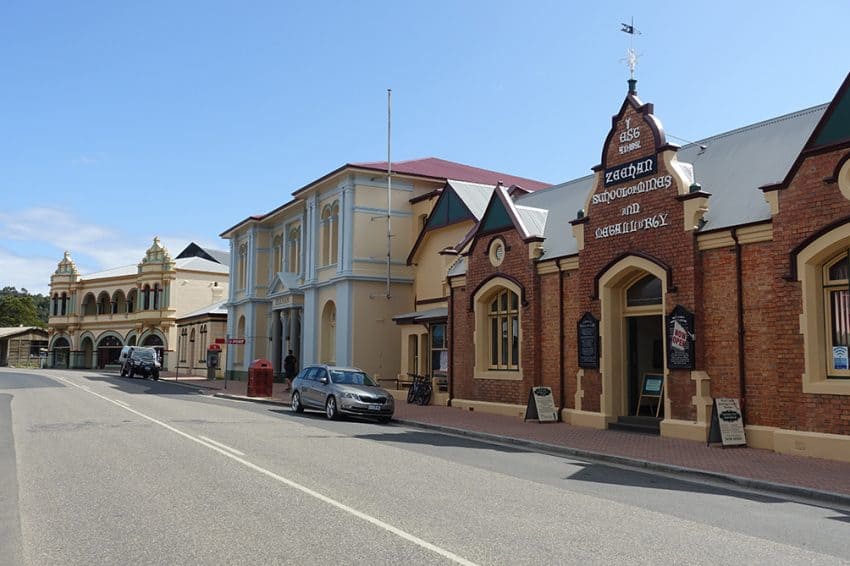
Travel Planner
The Place to Start
For a touring intro to Tassie with lots of things to see and do, check out: https://tasmania.com/
Best time to Go
Spring through to early autumn (November to April), but the weather can be cold and/or wet at any time – think Washington state.
Getting There
The best way to get to Tassie is to take your own rig on the Spirit of Tasmania ferries. For more details, check the web at: https://www.spiritoftasmania.com.au/
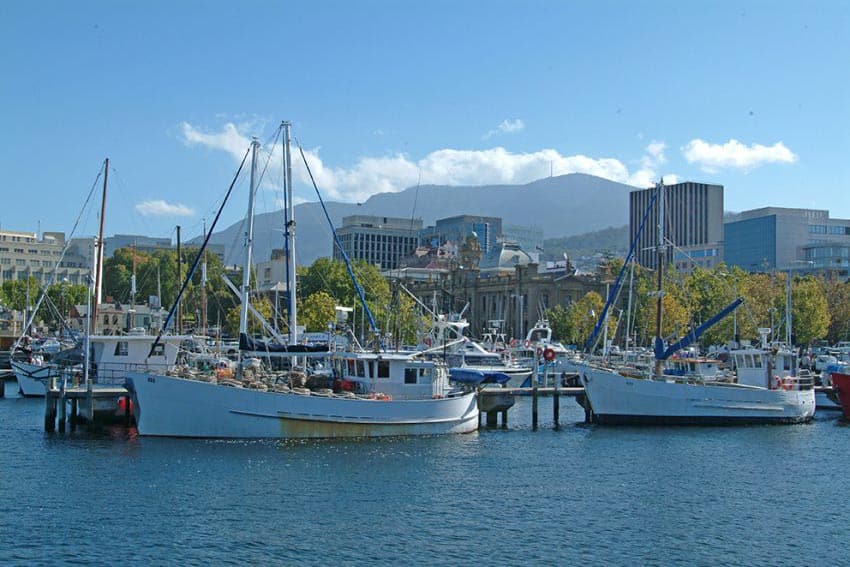
Tasmania Maps and Guides
The best guide for the 4WD tracks and bush camping in the state, is ”Offroad Tasmania’, by Chris Boden.
The best touring map is the ‘Tasmania Visitors Map‘, which you can pick up on the ferry.
Hobart & Surrounding areas – Accommodation & Camping
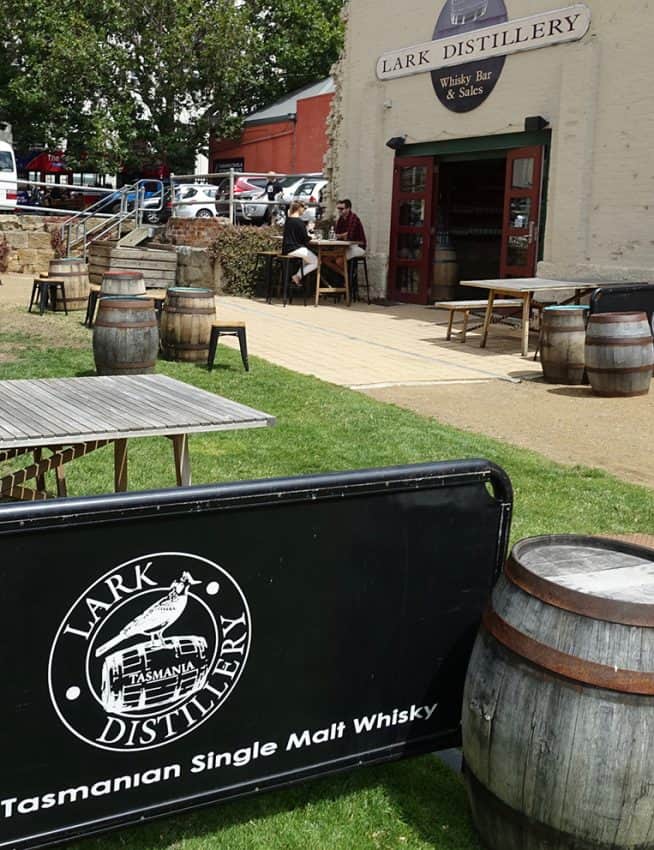
There’s a heap of accommodation in and around Hobart, the state capital. For caravan parks (think RV park – most have cabin accommodation as well) try:
Around Hobart & South
For permits for the 4WD tracks behind Mt Wellington, contact the Parks & Wildlife Service, ph: (03) 6233 6560.
For info on the Tahune Forest Reserve, the Air Walk and camping in the area, see: https://tahuneadventures.com.au/
For camping on Bruny Island see: https://parks.tas.gov.au/explore-our-parks/south-bruny-national-park/south-bruny-camping
Central Plateau Camping
https://centralhighlands.tas.gov.au/tourism/caravan-and-camping-sites/
West Coast
For info and tickets on the West Coast Wilderness Railway go to: www.wcwr.com.au/
Check out the delights of Strahan at: www.strahanvillage.com.au/en/explore.html
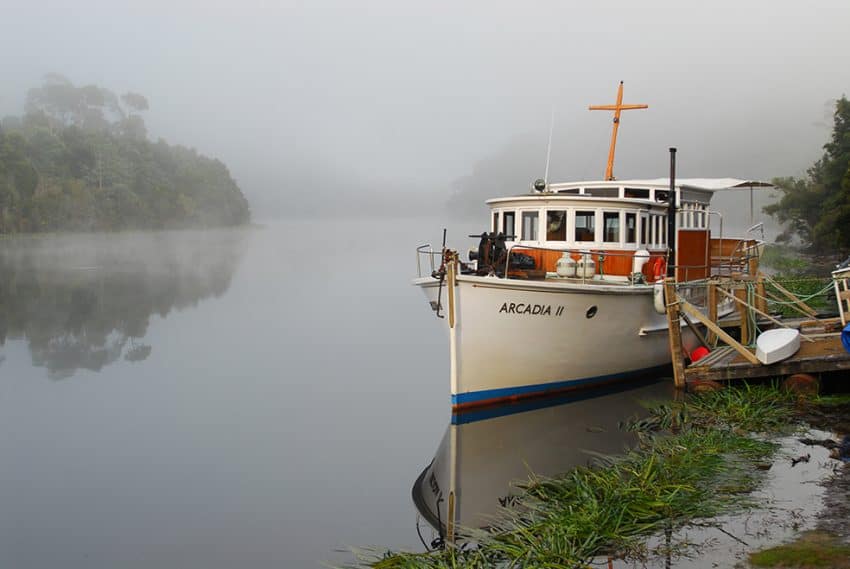
The bush camping at Macquarie Heads is basic but pleasant. A small fee is payable. See:
www.campingtasmania.com/macquarie-heads-camping.htm
Zeehan Museum is one of the best regional museums in Australia: www.discovertasmania.com.au/attraction/westcoastheritagecentre
At Corinna (https://corinna.com.au/) you can stay in the small camping area near the pub or in a range of accommodation.
Take a cruise on the ‘MV Acadia 11’, along the Pieman River.
The Arthur-Pieman Conservation Area takes up much of the coastal area of western Tasmania, including Sandy Cape. For access, info go to this site.
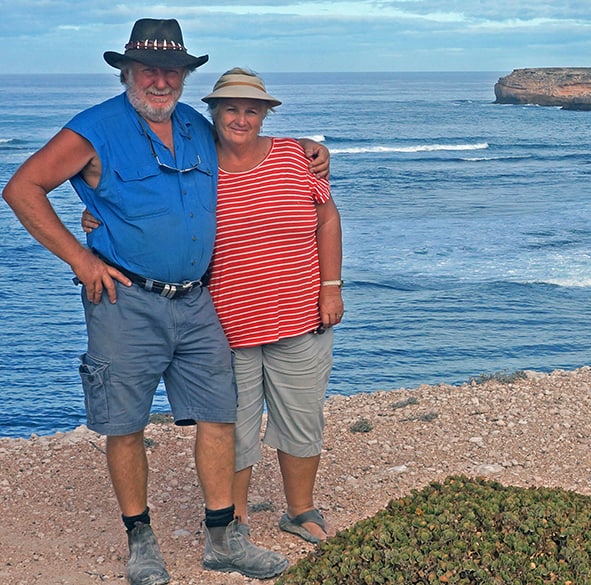 Ron and Viv Moon have been 4WDriving, touring, and writing about the remote areas of Australia for over 40 years. They wrote their first guidebook to Outback Australia in 1984 and Ron was editor of Australia’s leading 4WD magazine, 4×4 Australia, for 15 years. For the last 19 years he has been their roving Editor-at-Large. Visit their website www.dirtroaddiaries.com.au
Ron and Viv Moon have been 4WDriving, touring, and writing about the remote areas of Australia for over 40 years. They wrote their first guidebook to Outback Australia in 1984 and Ron was editor of Australia’s leading 4WD magazine, 4×4 Australia, for 15 years. For the last 19 years he has been their roving Editor-at-Large. Visit their website www.dirtroaddiaries.com.au
- Missouri Sports Travel Adventure: From Landmarks to Ballparks - January 21, 2026
- What First-Time Visitors Get Wrong About Visiting Iceland - January 15, 2026
- Bareboat Charter vs all-inclusive Crewed: Which Luxury Charter Fits You? - December 29, 2025


